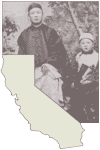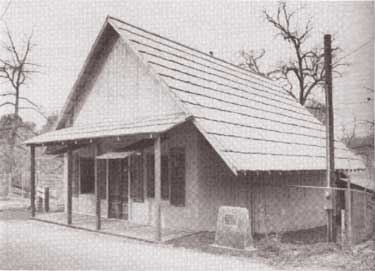![]()

Five Views: An Ethnic Historic Site Survey for California
MENU
Introduction
Early Contacts
1850s
1860s
1870s
1880s
1890s
1900s
Historic Sites
Selected References

A History of Chinese Americans in California:
HISTORIC SITES
Fiddletown's Chinese American Community
Fiddletown, Amador County
In the early 1850s and 1860s, Fiddletown was the trading center for a number of rich placer mining areas in Amador County such as American Flat, American Hill, French Flat, and Loafer Flat. Besides local mining and trading operations, a steam-powered sawmill was built in 1853 to provide lumber from local forests.
Chinese immigrants first came to Fiddletown to seek gold. Although it is said that Fiddletown had a Chinese American population of between 3,000 and 12,000 and that it once was second only to San Francisco's Chinatown, the U.S. Census records do not substantiate this. The Chinese American population dwindled due to the decrease in mining activity and racism, including enactment of the Chinese Exclusion Law of 1882. By 1900, only 11 Chinese Americans lived in Fiddletown.
Evidence of Fiddletown's Chinese American community is represented by three historic buildings.
1. The herb shop (Chew Kee Store) is a one-story, rectangular rammed-earth building, facing east. It has wooden gables and a corrugated metal roof. Earlier photographs show a higher pitch to the roof, which was covered with wood shingles. The facade has two windows and a door, all with iron shutters. The windows are double-hung, with 16 panes (some with original glass), wooden sills, and iron shutters on both sides and above. There are no other windows. The west side of the building has a door and several wooden additions. In back are a well and an outhouse.
2. The gambling hall is a one-story, rectangular brick building, facing west. It has wooden gables and a corrugated metal roof. The facade has only one door and a small window, both covered with iron shutters. There are no other doors or windows.
3. The general store is a two-story, rectangular brick building, facing west. It is painted white and has wooden gables and a corrugated metal roof. The facade has only one tall door on the ground floor and two windows on the second floor. There is a small door on the north side of the building, and a larger one on the east side. All doors and windows have iron shutters. The general store may also have served as a religious temple at one time.
Although the general store and gambling hall are both vacant, the Chew Kee Store is currently a museum.
The Chew Kee Store has a long, prestigious history. It was founded as a herb shop by the famous herb doctor, Fan-chung Yee, who came from China to care for Chinese miners around 1850. He had offices in Sacramento, Fiddletown, and Virginia City, Nevada, and was joined in his practice by his second son, T. Wah-hing. Both effected many famous cures, and took care of the sick of all races and nationalities.
About 1870, the herb shop was turned over to a man known only by his store name, Chew Kee, who lived in the store with his wife. At this time, the store sold groceries, herbs, and other supplies. Chew Kee ran the gambling hall across the street, which was a social center for Chinese residents.
Around 1911, Chew Kee and his wife returned to China, leaving their extensive property holdings to their adopted son, Chow-you Fong (also known as Jimmie Chow). Jimmie Chow worked as a black smith, lumberjack, butcher, and carpenter. He died in 1965, the last Chinese American resident of Fiddletown.

Fiddletown's Chinese American Community, Fiddletown, Amador County
NEXT> Gasquet Toll Road
Last Modified: Wed, Nov 17 2004 10:00:00 pm PDT
http://www.cr.nps.gov/history/online_books/5views/5views3h34.htm
![]()
 Top
Top